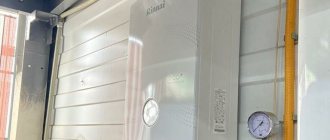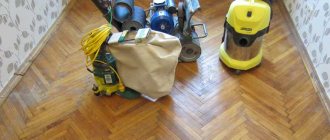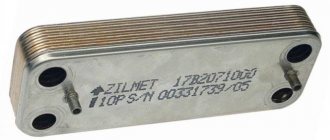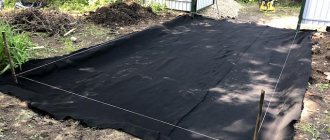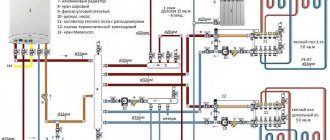Here you will learn:
- Is it worth taking on the repairs yourself?
- Methods for self-diagnosis of faults
- Causes of gas boiler breakdowns
- Possible malfunctions and DIY repair methods
- Performing major repairs of a gas boiler
- Seasonal service
A gas heater is a rather complex unit. Its structure is based on the following components and systems:
- a furnace in which fuel combustion occurs;
- air supply and combustion product removal systems;
- a heat exchanger in which a flame heats water or coolant;
- automation systems;
- security systems.
The firebox, or combustion chamber, can be open or closed. In the first case, the air required for fuel oxidation enters the firebox through the air intake on the body from the room in which the unit is installed. Combustion products are removed through a traditional chimney that rises above the roof. The craving is formed naturally.
In a closed chamber, there is no exchange of air between the interior spaces and the heater. Air enters from the street, and exhaust gases are removed back through a horizontal coaxial chimney passing through the wall of the building. A fan is used to create draft.
The heat exchanger may have one or two circuits. The first, closed circuit is connected to the heating system; the coolant circulates in it using a pump. A second circuit can also be installed on a gas boiler; water from the water supply system passes through it and is heated. This circuit is open; water is supplied due to the pressure created by the pumping station.
Automation and safety systems maintain the specified coolant temperature and monitor trouble-free operation of the device. In modern models they are combined into a common computerized control system.
The security group includes the following subsystems:
- draft sensor, when draft falls below a set level, it turns off the gas supply;
- an additional draft sensor in the exhaust channel protects against combustion products entering the room;
- the flame controller monitors the operation of the burner and turns off the supply when the torch goes out;
- an emergency valve relieves coolant pressure if it exceeds a preset value;
- The pressure sensor stops the unit if the pressure and flow rate of the coolant drops below a set value, for example, due to a leak.
Automation and safety systems on boilers with an open chamber and natural circulation of coolant can be mechanical - then the boiler does not require electricity to operate. More advanced and economical boilers require a constant power supply to operate the fan, circulation pump and control system
Is it possible or impossible to repair a gas boiler without a specialist?
A typical gas boiler consists of many elements, which can mainly be combined into 3 groups:
- Burner.
- Security blocks.
- A heat exchange unit equipped with several additional devices, which include a fan, circulation pump and many others.
A simplified structure of this mechanism can be represented as follows.
If you detail the picture, you can find about 2 dozen different elements in the device.
The main danger during repairs is a possible gas leak. This can happen due to improper repair, dismantling or installation of equipment related to the fuel supply.
Therefore, it is better to entrust the repair of these parts of the structure to a specialist. Also, you should not troubleshoot electronic equipment in gas boilers yourself. Automation is a specific device, therefore, without the appropriate qualifications, it is almost impossible to correctly carry out restoration work and repair such equipment yourself.
What can you repair yourself?
All other elements can be repaired yourself, for example:
- The heat exchanger is washed manually (to do this, the unit is dismantled, after which it must be correctly put back in place). You can perform this work without dismantling - using pumps.
- Chimney cleaning will be needed in cases where there is a problem with draft (mechanical or chemical removal of blockages is carried out).
- Repair of the boost fan by lubricating its bearings with technical oil.
In fact, you can repair a gas boiler yourself only in cases where there are mechanical damages or blockages that can be easily identified visually (or by smell).
Other breakdowns are considered more serious, so they are repaired with the help of a specialist, and not with your own hands.
Connecting a room thermostat
A room thermostat is a convenient and useful device that allows you to regulate the temperature of the air, not the coolant, in the heating system. The default sensor monitors the outlet temperature of the heating agent.
This does not give a correct picture of the state of the microclimate in the room. For example, when the outside temperature rises, the room becomes hot .
But the sensor cannot track this, and the extract air temperature is within the limits specified by the mode, so from the point of view of the system, everything goes fine, in accordance with the boiler settings.
If a room thermostat is used, the burner will turn off much earlier, which will improve the microclimate in the room and significantly reduce gas consumption.
To connect the room thermostat, you need to set the boiler's own element to the maximum temperature.
It will only work as an overheat limiter . The external unit is connected at one end to the automation unit, and at the other to the boiler thermostat. By default, a jumper is installed between the contacts, which must be removed and the thermostat connected.
IMPORTANT!
It is necessary to use the appropriate brands, for example - CEWAL RQ10. Installation of a thermostat is only possible on boilers marked N (with the SIT 820 NOVA automation unit).
The main causes of gas boiler failure
Before you figure out how to repair a gas boiler with your own hands, it is useful to understand why exactly malfunctions occur. Correct understanding of the reasons will help to avoid the problem in the future. Practice shows that 4 harmful factors most often affect:
- Power surges - this problem is especially relevant in remote towns and villages. Modern equipment is necessarily equipped with stabilizers, as well as energy storage devices, which ensure the device operates for a short time even after the source is turned off. Therefore, if there are no such devices, you should purchase them in advance.
- Poor quality water - this problem arises in cases where the equipment is used not only for heating, but also to produce hot water for domestic purposes (double-circuit gas boiler). It is not the water itself that harms the equipment, but the presence of salts in it, which increase hardness. If the concentration of these insoluble substances is quite high, this can lead to wear and tear of the equipment in just 1-2 seasons. Therefore, it is necessary to take care of installing filters that purify water.
- Installation errors can lead to quite serious consequences, including irreparable breakdowns and failure of all equipment. Therefore, you can trust this work only to qualified specialists.
- frosty winters can also play a role . Typically, during such a period, neighbors turn on the equipment at full power, and it operates in this mode for a long time. As a result, the pressure in the gas pipeline system drops noticeably, and the boilers begin to work largely in vain. At this point, you can use equipment that runs on another fuel (for example, diesel). It makes sense to purchase it if the region has long, harsh winters.
Power outages
It happens that the voltage in the electrical network drops below the permissible level. In this case, the boiler immediately goes out, since modern automation can detect low voltage. When the power supply is restored, the same automation will turn on the burner, so most of these failures can go unnoticed. However, this mode of operation is harmful to electronics, so they may fail over time. So if suddenly the gas does not light up when voltage appears in the network, something may have happened to the automation. To avoid such a scenario, it is better to buy a voltage stabilizer.
Table of common breakdowns
The most common gas boiler breakdowns are described in the table.
| problem | possible reasons | what to do |
| small burner flame | air entering the gas pipeline or nozzles becoming clogged | call a technician |
| the burner goes out quickly | malfunction of the ionization electrode | |
| the flame comes off, the nozzle makes an unusual noise | the draft is too strong (the chimney pipe is high) or the pressure in the system is not adjusted | reduce cravings |
| the boiler does not turn on | different | you can turn the plug to change contacts and turn it on again |
| disruption of automation and electronic equipment | different: difficult to eliminate on your own | call a technician |
| incorrect operation, voltage drop | power fluctuations | install stabilizer |
| scale blockage | hard water | clean and install filter |
| overheat | heat exchanger clogged with soot | clean the mechanism manually |
A video review of possible flame problems and their causes can be seen here.
Availability of automation
The automation of the Lemax gas boiler sometimes significantly expands the scope of use of the device. Above is a list of some characteristics that should be followed when choosing gas heating equipment. Knowing them, you will be able to independently determine the modification of the unit, which is the highest priority. Initially, you have to determine the heat loss of the building, and only then calculate the power of the boiler.
Sources
- https://teploclass.ru/kotly/gazovye/gazovyj-kotel-lemaks
- https://www.stroy-podskazka.ru/otoplenie/kotly/lemaks/
- https://utepleniedoma.com/otoplenie/otoplenie-doma/kotly-lemaks
- https://teplospec.com/gazovoe-otoplenie/kak-vklyuchit-kotel-lemaks-pravila-ekspluatatsii.html
- https://fb.ru/article/229439/gazovyie-kotlyi-lemaks-otzyivyi-i-instruktsiya
How to repair a boiler yourself: step-by-step instructions
Once a specific breakdown has been accurately diagnosed, you can begin to fix it. Of course, if you are sure that this is a feasible task that does not require special skills and equipment.
Preparatory stage
- First of all, you need to disconnect the device from the power supply and also turn off the gas valve tightly. Even if the repair is not related to elements in direct contact with fuel, this condition is mandatory.
- If it is difficult to estimate the time of restoration work, and it could theoretically take several hours, you should completely drain the water from the heating system or pour in an antifreeze solution (if it is not there). The fact is that during the repair the air temperature in the room may drop to negative values, and the water will freeze.
- Safety precautions: along with turning off the gas valve and de-energizing the system, you should also remember that before repairs, the working surface must cool to an acceptable level. Otherwise, touching it may cause burns.
Cleaning the heat exchanger
If the boiler overheats, this may indicate 2 reasons:
- The automation that controls the operation of the device is faulty.
- The heat exchanger is clogged (soot deposits).
Automation can be repaired only with the help of special equipment, which in most cases is not available in the house. But it is quite possible to clean the heat exchanger yourself.
The sequence of actions is as follows:
- Turn off the boiler and allow it to cool.
- The taps are turned off.
- Remove the front cover.
- Dump the remaining water (open a hot water tap or a valve inside the mechanism to drain water from the heating system).
- Remove the heat exchanger.
- The heat exchanger is cleaned first mechanically, then in a solution of vinegar and citric acid, taken in equal quantities (you can use a tablespoon per liter of water). Instead of a solution, you can also use special formulations purchased in the store.
- The heat exchanger is kept in this mixture for 1-2 hours until completely cleaned.
- Then rinse with running water and wipe dry.
- Put the heat exchanger back, close the lid, and fasten all the parts.
Chimney cleaning
Reduced draft and overheating of a gas boiler can certainly be associated with a clogged chimney. It is in this part of the system that the largest amount of soot accumulates. However, dirt accumulation is quite rare since the gas does not produce a large amount of waste.
Using a chemical solution through a booster
To perform this cleaning method, it is necessary to use special equipment - a booster, with which an acidic washing solution is pumped into the heat exchanger.
Then, over a long period of time, it is necessary to drive the solution through the pipes several times. The result will be that the deposit will dissolve and will be removed from the equipment along with the liquid used for flushing.
After flushing, the throughput and thermal conductivity of the gas boiler will increase. An acidic solution can dissolve any stubborn contaminant, which can be carbonate salt deposits or ferric iron deposits. A small amount of acid remains in the pipes, which is neutralized. To do this, use a special solution, which is launched into the heat exchanger after the washing is completed.
Do-it-yourself repair of double-circuit boilers
Double-circuit boilers should be repaired especially often, since they work in intensive mode, heating rooms and storing hot water for domestic needs.
NOTE
During the repair of gas boilers, structures will almost always need to be dismantled. You need to carry it out carefully, remembering the connection sequence, so that later you can correctly assemble all the elements of the system.
Repair of a wall-mounted gas boiler (cleaning and flushing the heat exchanger with special means) is clearly shown here:
Organization of access to the control system
Attention!
Switch off the power supply to the boiler at the external switch before performing the following operations.
Checking the status of fuses
- Remove the back cover on the control panel
(Fig. 1.54);
- Remove the fuses (Fig. 1.55).
Removing the timer
- Disconnect the electrical connector “P1” from the timer (Fig. 1.56);
- Unscrew the screws “Q1” (Fig. 1.57);
- Remove the timer from the control panel (Fig. 1.58).
Removing the control board
- Disconnect the boiler from the power supply
- Remove the back cover of the control panel
- Disconnect all electrical connectors on the control board
- Unscrew the screws “R1” (Fig. 1.59);
- Detach the front decorative panel from the base of the control panel
- Unscrew the “S1” screws and remove the control board (Fig. 1.60).
Malfunctions of gas boilers: prevention
Obviously, a preventative measure is always better than repairing a breakdown that has already occurred. Therefore, it is important to know about those ways to prevent malfunctions of gas boilers that will help you avoid trouble and practically guarantee that the problem will not be taken by surprise.
First of all, you should refer to the instructions from the manufacturer, which detail the rules for operating the mechanism. As a rule, they are almost the same for different models.
Cleaning the heat exchanger
This is the most vulnerable place in the boiler, since a large amount of soot periodically accumulates in it. The heat exchanger is in most cases made of stainless steel, less often - of copper. It must be cleaned at least once every 3-4 years.
This is done with a metal brush. And if the mechanism is made of copper, use a metal sponge, which is used for washing dishes. It is advisable to monitor its condition annually for contamination, especially after a cold winter, when fuel consumption increases significantly.
Pressure check
Carried out periodically, several times a year. The optimal range for each model may vary slightly, but is usually between 1.0 and 2.0 bar (if the mechanism is cold). If the indicator drops regularly, it is preferable to immediately contact a service company.
Checking the water level
This is a very important requirement. After all, if the volume of moisture is less than standard, this can lead to fairly rapid wear of the mechanisms. The level is monitored annually, especially often after repair work, when moisture can evaporate faster than usual.
In this case, every summer, before the start of the next heating season, all liquid should be removed, and parts and components should be carefully inspected for the presence of scale, dirt, damage and other malfunctions.
Proper boiler care
Includes the usual safety measures:
- Do not direct water jets at the equipment, i.e. It can only be washed with a cloth (by hand).
- Jets of air and steam, especially hot ones, are not allowed to enter. Therefore, it is better not to place equipment in the kitchen.
- It is also prohibited to place any objects on the surface of the unit.
- Impacts, mechanical impacts, radiation, etc. are not allowed.
- If there is a long period of downtime (1 or several seasons), the equipment is prepared for it in advance. For example, you need to take care of protection against freezing, which is described in detail in the instructions for the gas boiler.
Thus, in some cases it is indeed possible to repair a gas boiler with your own hands.
But if the breakdowns are quite serious, or the malfunctions of gas boilers are not completely clear, there is only one way out - to invite a specialist from a service company.
Why is blood pressure rising?
If the pressure in the system increases, this usually indicates that the water level has increased. This problem can lead to serious emergencies and even an explosion of a cast iron radiator. To reduce risks, the installation included an expansion tank that collects excess water.
An increase in pressure indicates problems with the tank. Problems can occur in the membrane, which sag in order to make room for an increased volume of water. Sometimes it breaks, and can also be loosely fixed to the walls. As the volume of fluid increases, there will be nowhere for it to go, which will cause an increase in pressure.
The situation can be corrected by replacing the membrane or the expansion tank itself (if that is the problem).
Plasterboard construction
In this case, only moisture-resistant drywall is used. Due to the material availability, simplicity and speed of installation, this method of masking communications is quite popular.
The basis of such a box will be a metal or wooden frame covered with plasterboard. You can decorate the top to your liking.
At the end of the installation, windows are cut into the drywall to access the valves and closed with decorative doors.





